#the hauntology of everyday life
Link
A Hauntology for Everyday Life
Meaning, Language, and Subjectivity
Ghosts, Metaphors, and Structures of Feeling
The Haunted Objects of Desire
Hauntology sans Exorcism, from Justice to Networked Subjectivities
Epilogue by Michael M.J. Fischer: Hauntology’s Genesis, Catacoustics, and Future Shadows
Correction to: The Hauntology of Everyday Life
1K notes
·
View notes
Photo

Christmas Eve, 1985 More Here
#'80s#80s#Christmas#Christmas Eve#Christmas Aesthetic#80s aesthetic#snapshot#vernacular photography#everyday people#everyday life#memoradelia#The Palace of Green Porcelain#The Invisible Museum#hauntology
6 notes
·
View notes
Quote
What haunts is not that which is gone, it is that which was expected to come but whose condition of arrival has been foreclosed, and the ghost is an advocate of the promised future that was unrightfully canceled when the past was destroyed.
Sadeq Rahimi, The Hauntology of Everyday Life
3K notes
·
View notes
Text
“The present day “nostalgic” yearning for more substance in everyday life is overwhelmingly evident in today’s generation. It makes sense that we would look to the past for a grasp of our present and distant future.”
- Christa Leah, Hauntology: The Feeling of Unprecedented Nostalgia
24 notes
·
View notes
Text
On Border Hauntology
“Ghosts or phantoms can mark the death of the ideas from the old world, as well as announcing a new principle of life.”
-Bruno Bosteels
The haunted dreamscape of the borderland unconscious comes to the surface in quematrasgos, the new release by experimental-electronic-Tejano duo Nudo. Listening to the seven tracks that make up the album, one feels as if they’re drifting across the histories of cultural lost futures, repressed political memories, and the communal desires that were once vibrantly alive along the US/Mexico border. Desires which manifested and materialized in multiple ways through the cultural expressions of the region.
By conjuring the sounds of corridos, norteño, and cumbia sonidera, the alien-like factory noises of the hellscape known as maquiladora city, as well as the vernacular folklore and jokes dealing with the violence permeating everyday life in the border, they effectively create a noise-sound-collage (in the style of Luigi Russolo’s Art of Noises) resembling the utopia of “hallucinatory visions in desperate times” described by Fredric Jameson in Archeologies of the Future. This striving for utopia evident in their futurist use of sampled regional music mixed with cosmic and weird sound effects (a practice originated in sonidero culture) places Nudo in the tendency of hauntology within the borderlands.
Hauntology as an aesthetic sensibility first emerged in Britain in order to deal with a cultural impasse defined by an inability to collectively imagine new futures at the so-called end of history. As the theorist Mark Fisher says, “the failure of the future is what defines hauntology more than anything.”
For Fisher, this ‘failure of the future’ had two interconnected effects: First, on a political level, it resulted in the loss of the radical imaginaries and aspirations launched by the revolutionary movements of the last century, by the students of ‘68, the anti-colonial struggle, and the movement for socialism that sprung across the Americas. Second, on an aesthetic level, electronic music ceased to be experimental and stopped pursuing the new, instead becoming mesmerized with the old forms and styles of times past. As Fisher argues, “by 2005, electronica was no longer capable of evoking a future that felt strange or dissonant.” These historic defeats suffered by emancipatory movements led us to an era “characterized by its inability to find aesthetic forms adequate to the present, still less to anticipate new socio-political futures.” (Jameson)
Hauntology represents an aesthetic response to the cancelation of the future, to the collective inability to think of a world radically different from our own, whether through music or our political imaginaries. Hauntological artists turn nostalgically towards the the past not in order to mourn and idealize it in relation to our present, but rather to actively reinterpret and remobilize half-forgotten cultural memories that promised alternative forms of futurity.
The ghosts, specters, and lost futures sought out by hauntology are emblematic of historical events that serve as reminders that capitalism is neither natural nor eternal, that there are other ways to organize society based on principles of solidarity and collectivity. They serve as aide-memoires of the times when struggles against capitalism, along with counter-cultures experimenting with new ways of being and seeing, were alive and ever-growing. Bruno Bosteels writes: “An event appears as a ghost both for what it no longer is and for what it has yet to be.” The aim of the hauntologist is to trace these ghosts haunting our present in order to reactivate the alternative futures “that have yet to be”.
To think about the nature of border hauntology, some questions arise: How does border hauntology deal with this failure of the future? What are the ghosts and lost futures haunting the borderlands today? What do the radical elements found in marginal cultural expressions tell us about the possibility to imagine alternative futures? What forms of futurity existed in the border which were foreclosed by capitalist forms of “progress”? Are there forms of a vernacular modernism found in border culture and art?
Nudo offers us an opportunity to deal with these questions as they take us across the simultaneously utopian and nightmare logic of the contemporary borderland unconscious. By way of a sonic dérive we trek alongside contemporary migrants-turned-psychogeographers stalking the ruins of a decaying civilization along the Rio Grande. T hey guide us through its sonic landscapes composed of cyber-sonideros, ghosts singing corridos, and cholombianos dancing chuntaro-style to deconstructed 3ball beats.
The mixing of traditional musical styles of the border with haunting soundscapes, which end up transforming the music into something alien and estranged, is characteristic of their aesthetic. This approach could be seen as serving a dual purpose: while the samples of corridos and sonideros function to invoke the lost futures they contain, the phantasmagoric sound effects layering the music allow for the return of the repressed histories of the region, namely the grinding conditions of life and work confronted by workers, farmers, migrant travelers, and so-called “illegal aliens”.
These repressed elements alluded to in the release point to the horrors capitalism requires to sustain and reproduce itself, requirements which are met in the margins of the system while perpetuating remnants of colonialism. Writing about the British colonization of India, Karl Marx touched on the reality of the borderlands of capitalism: “The profound hypocrisy and inherent barbarism of bourgeois civilization lies unveiled before our eyes, turning from its home, where it assumes respectable forms, to the colonies, where it goes naked.”
Doesn’t the brutality of labor experienced in maquiladoras, the never-ending work of immigrant farmers, the constant harassment and persecution of “illegal aliens” by the militarized border patrol, as well as the narco and State violence endured in everyday life, represent situations that reveal the truth, or essence, of capitalism? To paraphrase Marx, the inherent barbarism of capitalism is unveiled before our eyes at the US/Mexico border.
Border hauntology, then, can be seen as a means to invoke the ghosts of lost futures while creating a sonic phantasmagoria that brings to the surface the everyday violence - whether in the maquiladoras or the immigrant detention centers - visible in the borderlands. These repressed histories are explored aesthetically in quematrasgos along with a search for the traces of lost futures available to us in certain cultural expressions of the border. Expressions which are grounded in communal forms of enjoyment and other possible modernities, as is the case in the sonidero movement.
The specter of sonidero culture appears in the first two tracks of the release, FFA and roundUP (irrigated dessert). FFA submerges us into the distorted ambient soundscape of cyberspace while the pitched-down voice of a cyber-sonidero informs us he’s performing from a youtube streaming channel. The heavily eviscerated pop song serving as background noise resembles the pastiche mode hauntology seeks to transcend. The cyber-sonidero informs us we are also located in the borderlands by using expressions particular to the region (What the hell are we doing? Vamos a prender el bote!)
In roundUp (irrigated dessert), the cyber-sonidero drops a cumbia rebajada track (a style of mixing cumbia in which the music is pitched lower in order to create a haunting effect) while, like Virgil guiding Dante across the gates of hell and its labyrinthine structure, he announces our descent and crossing into the hellish side of the borderlands, into lo real: la frontera del alma, the real: the border of the soul. In the process, he recites its memories and spaces of terror over a cumbia rebajada:
“Dios. Maquiladoras. Angeles. Ciudad Juarez, Chihuahua. La Frontera. Eagle Pass, Texas. Lo Real. Estado. La Frontera del Alma. Tiempo. El Mezquite. Occurencia Vertical. El Paso del Águila. Estudio Esotérico. Estudio Prehispánico. Tormenta. Lo Verdadero, Lo Real, Lo Mítico. Desencarnado. Milagro. Dios del Charco. Dioses Castrados.”
“It is true that the old world belongs to the philistine. But one should not treat the latter as a ghost from which to recoil in fear. On the contrary, we ought to stare the ghosts in the eye!”
-Karl Marx
The sonidero culture invoked throughout the release point to the lost future being traced, offering an utopian vision in conflict with the underworld of the borderlands. Remnants of the sonidero movement still survive in the margins, whether amongst immigrant communities in the U.S. or in Tepito, albeit under constant attack by the repressive apparatuses of the State.
The futurist aesthetic and modernist ethos of sonideros are sometimes neglected by critics and musicologists. Sonideros are reduced to an exotic curiosity. They are viewed as traditional relics of some pastoral past, or as a form of resistance against the intrusion of western, or rather American, culture, due to their age-old Latin American and Caribbean music selection. In consequence, the potential futures they contain are ignored. Without a doubt, far from dealing with reality, these perspectives reflect the critics deep-rooted and erroneous belief that the modern and the new could never emerge from the margins of world capitalism.
Sonideros are better understood as modernist future rhythm machines that build bridges of solidarity within and across borders, while enforcing the right to the city. According to the musicologist Dario Blanco, “sonideros are heirs, upgraders, and transformers of a deep tradition of collective rituals.” In her essay Alternative Bodies on Streets, Cathy Raglan points to their transmodernist nature: “Sonideros present an idiosyncratic fusion of tradition and modernity in which the roots oriented sounds of rural vallenato-style cumbia are combined with the sonidero’s space-age sound effects.” Another feature they inherent from modernism is the strategy of turning the familiar strange and the strange familiar. As Cathy Raglan explains, “sonideros employ technology to alter their voice through filters, to alter the pitch, to create voices which are deep, grandiose and booming through the streets as if coming from another dimension.”
Ruben Lopez Cano, editor of Sonideros en las aceras, vengase la gozadera, writes about the sonideros approach to the city and public spaces: “The sonideros ability to close the street for public use makes people feel the power to partake in body expressions that deviate from the norm.”
These are some of the lost futures mourned and remobilized in border hauntology: the radicality of modernism, as well as the the right to the city and public spaces. These dreams and political aspirations can be traced through the actions and demands raised by the students of 1968. Describing the cultural effects of 1968 in Mexico, in his essay “The Melancholy Left”, Bruno Bosteels writes: “One of the lasting consequences of the events of 1968 consists precisely in displacing the borders of the political so as to include the everydayness - the infra-ordinariness, so to speak - of those who are the subjects of struggles for justice.”
By taking over the streets to create public spaces where joyous collective energies can emerge, where people can begin to sense what having control over our lives and cities could truly mean, sonideros remind us that alternative futures continue to exist in the margins, not only virtually but in concrete terms. As the surrealist poet Paul Eluard wrote, “there is another world but it is in this one.” The task is one of theorizing and acting in ways which expand such worlds which point towards a communist modernity.
In essence, the sonidero movement is a reverberation of modernism. In effect, the specters of modernism and its promise of the new are today roaming the margins of the so-called underdeveloped world, persisting in the aesthetic and political strategies of sonidero street culture. They allow us to contemplate an alternative modernity where technology and machines become means of creativity and joy rather than infernal machines of exploitation.
“Have you heard the cry of the dead?”
Doña Eduviges Dyada
Aside from the lost future of sonidero culture and its vernacular modernism there are other hauntings occurring in the borderlands. Sinister ghosts also appear in a region whose history has been defined by endless violence and necroeconomics. What does Nudo’s phantasmagoria of repressed border histories reveal? What forms do the central affects of hauntology, those of nostalgia and melancholia, manifest in the border?
Given the savagery and dispossession that continue to permeate the region, the other form of haunting that appears deals with the victims of the social horrors encountered in the region. It deals with the countless deaths of migrants risking their lives to cross over the Rio Grande, a space which today has been turned into a war-zone, as well as with the plague of femicides continuing to grow along border, or historical events like the massacres of students fighting for a better world, whether those of Tlatelolco in 1968 or Ayotzinapa in 2014.
These ghosts of these victims are spectrally present in the last track of the release, eCorrido. The track begins with a dubbed narco-corrido playing softly in the background, invoking the “war on drugs” and the senseless deaths of its 85 thousand victims (according to the dubious official figures of the government). A corrido begins playing amidst alien-like sci-fi effects insidiously dominating the atmosphere, while the singer struggles to be heard as he drifts into a cloud of impenetrable smog. The muffled singing leaves one wondering whose voice we are listening to and what message they are attempting to convey. The voice could very well be that of a ghost of one of the victims of narco wars, one of the massacred students of 1968, or a migrant that died under the brutal heat of the Arizona dessert, attempting to narrate the realities of Mexico’s repressed history. Throughout the corrido, they persist in their attempt to overpower the alien forces - symbolic of the maquiladoras, narcos, and corrupt politicians - that have taken over the border and our lives.
Border hauntology isn’t just dealing with lost futures, ghosts of by-gone eras, or with the “specter of a world that could be free.” The presence of ghosts belonging to contemporary history is precisely the result of the necropolitics shaping the lives of the oppressed in the border. As Bruno Bosteels writes in his study on “Politics, Psychoanalysis, and Religion in Times of Terror,” “In Latin America, ghosts don’t only appear to its inheritors; but also at the time of the events themselves.” The importance of present-day histories of violence to be heard in order to grasp the truths of capitalism explains the apparitions of these specters in border hauntology. The phantasmal voice in eCorrido is the voice of those being currently condemned to death by the logic of the system, voices demanding their presence in our collective imaginary. Put differently, in contrast to its British version, border hauntology goes beyond nostalgically mourning lost futures by dealing with the contemporary invisible ghost-like migrants that continue to die at the altar of capital accumulation.
The track Acequia also raises the question of giving voice to the dead whose histories uncover the systemic horrors surrounding us. On an aesthetic level, the track resembles Brian Eno’s Ambient 4: On Land in the way it shapes an ambience of simultaneously eerie and ethereal soundscapes composed of gentle guitar strums, distant voices that disappear as soon as they appear, along with, in the words of Mark Fisher, “a susurrating suggestion of nonorganic sentience”. What the sonic atmosphere of Acequia ultimately invokes through the incapacity of the impervious voices to express a single word, or the guitars to compose any kind of persistent melody, is a desire to give ontological presence to the uncomfortable dead.
The track is also reminiscent of Juan Rulfo’s Pedro Paramo, a novel which, like Nudo, employs the method of phantasmagoria to conjure the ghosts whose stories allow us access to the real of capitalism. The ambient soundscape riddled with glimpses of dead souls unable to narrate their stories found in Acequia feels very much like Juan Preciado’s experience as he descents into Rulfo’s Comala, a ghost town symbolic of the land of violence and death that is Mexico. Juan’s first encounter in Comala is with Doña Eduviges Dyada, who asks him: “Have you heard the cry of the dead?” As Juan continues wandering through the crumbling and deserted buildings of a by-gone era, unable to find a living soul, he suddenly feels the presence of ghosts attempting to speak all around him:
“I saw there was no one, although I kept hearing what sounded like the murmur of many people in a market. A constant buzz without rhyme or reason, similar to that which is made by the wind rustling the branches of a tree in the night, when neither the tree nor the branches can be seen though their whispers can be heard. I didn’t dare take another step. I began to feel that the murmuring was getting closer and circling me like a swarm until I was able to make out a few wards, almost void of sound: ‘Pray to God for us.’ That’s what I heard them telling me.”
This desire to give voice to the uncomfortable dead whose histories convey the realities of our world is essential to Nudo’s border hauntology. By invoking the ghosts of such necropolitical events of past and present in a sonic register, Nudo converts Gayatri Spivak’s question “Can the subaltern speak?” into “Can the dead speak?”
3 notes
·
View notes
Photo
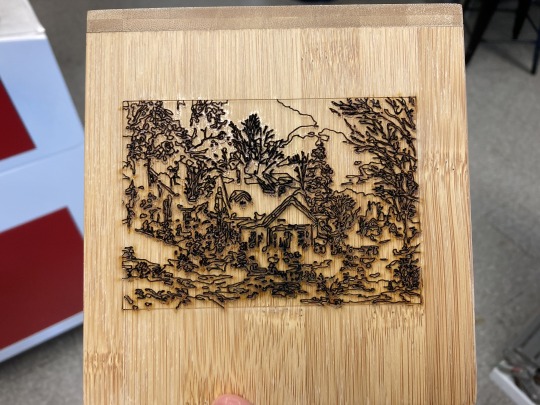
This week in the studio I finally had time to sit down and paint. After the group crit with Mark and with Denise, ideas and references of artists, and movements, new ways of displaying work, and ideas of new materials, etc. almost overwhelmed me. But I love when those discussions mix into a themed class, like a combined power, hauntology has taken root in my psyche. I discovered Derrida's work two years ago and have been in dialogue with past, present, and future ever since. I’ve been thinking about the way I am doing sort of ‘more of the same’ and yet something feels completely different in my drawings, paint by numbers, writing, and music. Each cast amongst these layers distilling and shaking within like a Mezcal Mystery Tour cocktail. I feel that art has found new registers in spaces that as a younger, less observant artist, may have been lost on me. Spaces find a way. Today I programed a laser machine to do a rendering of my paint by numbers of a home on a wooden tissue box. Is this something I lived before, or a future dream of mine? This was something very new to me. Laser by numbers? The CAD etching like Albrecht Durer.
First page of my new notebook:
New pages to fill how I want / poems or long winded rants on an image / studio notes or tales of love / philosophical renderings put me into words / so many days lead up to today / so many hours of sleep to get to this point /
In my dreams
I am living it awake and like a plant / light fills me with stream and flow / turn the page turn the leaf / belly up sun half-baked / Cherry Garcia, English Horn /
I am only anxious because I am so happy / I am only sad because the world is sad. / I feel pain because I am in a body / I remember pain because I have memories / But I also remember a renewed love daily. / It is re-newed not because I have rekindled some lost thing from the past, but rather, / met someone someplace new who reminds me everyday, that I love who I am / who they are / and being alive is beautiful. I hope everyone feels this at some point in their life.
0 notes
Text
Studio Update: A Test
I'm wanting to try different methods of presenting my ideas. In this next project, I'm attempting to use a sound element so right now my studio practice involves learning how to use this recorder to collect sound. This is a test collection of the sound of our studio space.
How it relates to hauntology : I'm collecting the sounds that I hear while sitting at a desk. What could be a solitary moment is full of noise that we have little control over. The "haunt" is that in our everyday life it's almost impossible to have a moment of actual silence. We will always be reminded of the excess we are surrounded by even in a "quiet" moment sitting at an empty desk.
1 note
·
View note
Text
Theories of memory
Collective Memory & Trauma:
Memory could create repetitive and neurotic interruptions in the everyday present
Of all modernists, it was the surrealists who were most passionate about memory as they had fought in the world war
WW1, Memory, the Unconscious (1914-1918)
Sigmund Freud had first hand encounters with shell shocked soldiers
Nightmares were symptoms of shell shock
Memory is an effect of the outside world of the unconscious
Trauma is a rupture of the protective shield of consciousness
Memory is actually an effect of the outside world on the unconscious, we go around the world directed by the conscious, what is around us rather than what we have forgotten. Occasionally that shield can be ruptured and trauma can break through.
Trauma, memory, and corporeal acts: A dialogue between Freud and Ferenczi Maria Manuela Assunção Moreno & Nelson Ernesto Coelho Jr. To cite this article: Maria Manuela Assunção Moreno & Nelson Ernesto Coelho Jr. (2013) Trauma, memory, and corporeal acts: A dialogue between Freud and Ferenczi, International Forum of Psychoanalysis, 22:1, 17-25, DOI: 10.1080/0803706X.2011.652167 To link to this article: https://doi.org/10.1080/0803706X.2011.652167 Published online: 13 Feb 2012.
Uncanny Art & Sigmund Freud:
Uncanny refers to slight unease, uncertainty, disorientation and dissonance – makes the world of the everyday eerie
Shock, surprise or dejavu
Art that influences the behavious of the viewer, interact with the audience on the level of the body
Can be deliberate or unconsciousness – some deliberate techniques are double take, uncertainty, self-doubt, disbelief or making them feel estranged from themselves
An artwork can trigger a repressed memory or can be about a repressed memory
Freud invented psychoanalysis to treat trauma
Talking cure – through speech that memory is recovered and could recognise, face and change inner conflicts
Mystic writing pad – leaves a faint, but perceptible trace on the waxen surface below, a trace which can be seen if one were to lift up the sheet of the plastic and examine the wax surface.
This is how the psyche itself records material
It can record an infinite amount of material
The psyche system which receives sense impression from the outside world remains unmarked by those impressions which pass through it to a deeper layer where they are recorded as unconscious memory
In speech our conscious messages are infiltrated by unconscious ones – the idea of building up and erasing
Screen memory and palimpsest
The Surrealist were interested in Freud’s idea of the ‘screen memory’. The “one that comes to mind in the place of, and in order to conceal, an associated but repressed memory” (Burgin, p. 179).
The screen memory protects us from the repressed memory which may be too painful to look at
Freud said a screen memory is usually when “ an indifferent impression of recent date establishes itself in the memory as a screen memory” and it is the earlier memory that disappears behind it’ (Burgin, p. 179)
Truth can be lost in time and instead it is screen memories that dominate, as they do in the memories of nations.
What is the Freudian unconscious?
Identity is informed by what we don’t know, what is repressed, rather than what we do know (WATCH LECTURE FROM 45 MINS)
3 structures of self – the it, the ego and the super ego
Split self – split between what is known and what is unknowable, what is moral/immoral, what is sociable/anti-social, the unity of the subject is split by what we fear – the other – and that the other resides inside the self
A human being does not know themselves
HAUNTOLOGY AND LOST FUTURES
Derrida uses the the term hauntology in Spectres of Marx to designate the idea of constitutive absence, to talk about the idea that absence can define presence to the extent that that which is hauntological can neither be said to be present nor absent. History for Derrida is hauntological as is communism—what communism was, what it could have been, what it wasn’t. Hauntology is often used to designate what is called “lost futures” utopian futures that could have been or at least were imagines in the past but never came to fruition.
“The era of what I have called ‘capitalist realism’ – the widespread belief that there is no alternative to capitalism – has been haunted not by the apparition of the spectre of communism, but by its disappearance.”—Mark Fisher, Ghosts of My Life, introduction
Capitalist realism, is there an alternative?
Culture’s nostalgia on looking back at a time before capitalism where there were alternatives
Looking back on the vitality of the possibilities of capitalism
Mark fisher:
“While 20th-century experimental culture was seized by a recombinatorial delirium, which made it feel as if newness was infinitely available, the 21st century is oppressed by a crushing sense of finitude and exhaustion. It doesn’t feel like the future. Or, alternatively, it doesn’t feel as if the 21st century has started yet. We remain trapped in the 20th century”— Mark Fisher, Ghosts of My Life
What defined this ‘‘hauntological’’ confluence more than anything else was its confrontation with a cultural impasse: the failure of the future. 16
5 notes
·
View notes
Quote
Producing the new depends upon certain kinds of withdrawal — from, for instance, sociality as much as from pre-existing cultural forms — but the currently dominant form of socially networked cyberspace, with its endless opportunities for micro-contact and its deluge of YouTube links, has made withdrawal more difficult than ever before. Or, as Simon Reynolds so pithily put it, in recent years, everyday life has sped up, but culture has slowed down.
Mark Fisher, Ghosts of My Life: Writings on Depression, Hauntology and Lost Futures
12 notes
·
View notes
Text
(ESSAY) “One hasn’t caught a poem” – joining Alice Notley For the Ride, by Colin Herd

In this essay, Colin Herd writes from the side of dogs and car alarms and the everyday detritus of living in these ‘soupy’ times, where language draws us endlessly towards the possibility and withholding of more knowledge, more prediction, more answers and meaning. Exploring the rich, knotty and exhilarating poetics of Alice Notley’s recent book For the Ride (Penguin, 2020), Herd takes us on a jaunt through the ‘imaginative space of non-being’, zooming through windows and many portals of a rippling language, leading us into the shapeshifting realm of love, rebellion, tyranny, repeat and willowing new forms of (un)knowing.
“mebbe we’re just birds, orphic ones means, articuli of the blank” (92)
> This is an aside before I’ve even started but in my neighbourhood dogs are barking all the freaking time right now. Maybe it’s always like this and I just don’t notice because I’m usually at work during the day, or maybe it’s that they realise that stuff is screwed and weird right now… but wow… all these dogs wildly poeticise all day all night every day/night. Plus car alarms and house alarms which are of course dog-poets too as everyone knows, attuned to bewilderment as much as the next being.
> When things are trippy and scary, why not read something that’s even more so? And in the current Covid-19 crisis, I’ve been drawn to reading those poems that demonstrate an uncanny ability to know more always, to predict, to bring things into being, to foreshadow and foretell. I’ve been reading works that disrupt and destabilise, not to provide comfort in the disruption and instabilities of the present moment but to find ways of thinking disruptedly and divergently. One of those texts, a kind of prototext for that kind of thinking, is ‘On Notbeing’, one of those great lost works of presocratic philosophy that reminds us the best things in life are partial, basically unknowable & fragmented. In what we have available of ‘On Notbeing’, the poet-critic Gorgias zones out into the following elusive statements in a shadow-text, unpicking Parmenides’ ‘On Being’:
“Nothing exists; Even if something exists, nothing can be known about it; and even if something can be known about it, knowledge about it can't be communicated to others. Even if it can be communicated, it cannot be understood.”
As Barbara Cassin puts it, these statements “knot together” being and saying – existence and language – constructing politics and society in poeisis; but it isn’t just being and saying that are linked, it’s also being and non-being. Gorgias constructs the “city as an ongoing creation of language” by thinking logically through to a point where it’s impossible to imagine any stable “being”, that isn’t artificially constructed in the soupy language through which we experience it. Gorgias is on the side of the dogs and car alarms signalling their objection to any stable objective being, the “articuli of the blank”: sheer barking poetic insistence. It’s almost time for us to clap again.
> This imaginative space of non-being, this thinking-through of what it would be like not to exist, is exactly the space that Alice Notley’s new book For the Ride takes the reader, carefully lowering us down like a figure being dropped from a great height into a game, but the game is what feels like a live unfolding Zoom transcript of ghost-Gorgias-as-babysitter-to-zoom-bombing-baby-ghost-Derridas caught in self-isolation with endless versions of themselves. And Gorgias seems to be asking how many Zoom windows it is possible to open up at once to short-circuit the tech. And how exhilarating is this poem which takes poetry to breaking point! It’s a roughshod exploration of languages rippling and ripening around the questions: what might language be like if humans don’t exist? What worlds would language create if we weren’t around to limit, define them? Is posthuman talking / narrativizing / language possible?
> The actual agon / arena for these questions in For the Ride is “the glyph of chaos with willows”:
Oh but One’s not in time, what’s One in? Chaos, beautiful chaos –
But, too, One’s in glyph and it’s hard; learning a new way to go,
that is, Talk? proceeding on through… oh this might be round,
rounded. (1)
Notley’s poem creates spaces for us to imagine coming-to language. It’s a plant-like willowy coming-to language: “There are transversals, blurry poles—no they are lines” (1). The speaking here is plant-like in the way that Cassin reminds us Aristotle categorieses poets, those who speak nonsense: “Strage plants really, since like animals they make sounds with their mouths. Homoios phutoi, you are like a plant if you speak without meaning” (68). Notley’s text grows, abundantly. And reproduces almost magically – little branches of language falling – even upside down – and generating new growth. Notley’s is a coming-to language that might open up alternative spaces for being that don’t require us to situate ourselves and our egos in the same ways we’re accustomed to. Or, as it’s exquisitely put elsewhere: ”No way to evolve without pre-existence, assholes!”
> Oh just absorb us all with poetry like that! What else is poetry for but to swallow us up and then expel us somewhere we could never have been. This is a disorienting book, spinning the reader into all these different rooms of language, orienting us around characters – One, Wideset, France, Shaker etc – characters that are also spatial. In Queer Phenomenology: Orientations, Objects, Others, Sara Ahmed asks “How is it possible, with all that is possible, that the same form is repeated again and again? How does the openness of the future get closed down into so little in the present?” Notley’s poem lets us glimpse “the openness of the future”:
By changing this here langue. Whut evir’s done’s now diffirint words to. (117)
Yes it will come to you, is already maybe seeping into.
It’s like you do and more. No vocal cords? All’s a big vocal cord. (104)
And Notley’s poetry takes new shapes: calligrams of coyotes, arks, stars, bodies. This is such shaky & jittery poetry, more beautiful than I can swallow, such ground-shaking, tremulous, trembling, aquiver poetry. This is love poetry. Of course it’s fucking love poetry!... “loving it the langue” (48) … it’s love poetry because of the love that courses through every weird-ass overflowing sentence, “Step into this poem-scene, O one!” (105) It’s a love poem because it is so seeped in pleasure and because it rattles us in the s&m cords of its vocalities.
> Gorgias and Notley are scary and chilling and thrilling because they think past kill-joy-ing and administrations of bureaucratic humanity to glyphic hauntology, logocentricity, to language, to “someghost of langue” (102). Would language exist if humans weren’t around to think they made its rules up and got to police it? Maybe it would, maybe language branches would do their willow-thing. This is a poem that you want to bathe in – by cutting it out line by line and mulching them or something and wearing it around town like a mummy in a world you don’t exist in any more.
> This feeling isn’t that unfamiliar to those who are already in love with all the things a word can do when Alice Notley’s driving. And when I say driving I mean writing the most spooky, epic, eery poetry everwritten. The poet who takes us to places like this:
Where we except for those in charge are drained from giving ourselves to each other until there’s nothing left. (In the Pines)
You, dreaming about crazies, fearful of becoming one. What if
your yellow enraged aspect gets activated again,
screaming out your anger in a world that’s bizarre enough
to have invented it. (Culture of One)
I thought of words breaking open in the mouth but
also as jewels
of old sexless poets, of the dead dessicated
except for those emeralds or topazes
I still get a thrill when I say, emeralds and topazes. (Mysteries of Small Houses)
No world is intact
and no one cares about you.
I leaned down over
don’t care about, I care about
you
I leaned down over the
world in portrayal of carefulness, answering
something you couldn’t say. (Songs and Stories of the Ghouls)
Anything that comes into my mouth
is what I say. From where?
I scream for you
what you don’t dare know. Saying
I’ll know it for you
even though you don’t want me to (Negativity’s kiss)
“shifted” “& changed” “to spell Poverty” “instead of Presence” “He didn’t need” “to ride the train” “He’d made us poor” “in an instant” “They walk by”
“& make you poor” “They look at you & make you poor” “Surreptitiously I
began” “to remove my” “bits of jewelry” “my earrings” (The Descent of Alette)
as warriors take position
thousands of them
as leaves and flowers appear in their season
hearts burning to break them
singers without memory (Alice ordered me to be made)
Why does poetry that makes you want to ball your eyes out make you want to ball your eyes out?
> Alice Notley’s poetics always feels like what she wrote about in ‘The Poetics of Disobedience’ as “an immense act of rebellion against dominant social forces”, because her books are always so attuned to what those dominant social forces do and how they operate to delimit and reproduce the same-old same-old with all its deep political inadequacies. For the Ride feels like as well as pointing to dominant social forces also posits ways to imagine ourselves outside of them, even within the language-worlds of poems. In an interview with Shoshana Olidort in 2016 in the LA Review of Books, Alice Notley said:
“In The Descent of Alette, the tyrant is us. The tyrant is what enslaves us to our forms. The tyrant is the form of our life, the form of our politics, the form of our universities, the form of our knowledge, our thinking we know something. All of that is the tyrant. The tyrant is a liberal. The tyrant isn’t Trump. He can be part of it, but this tyrant is an extremely accomplished man who can do anything. Alette’s about the liberation of women, but it’s also about the liberation of everyone. If you keep half of humankind down, then everybody is oppressed.”
Can poetry actually be the willowlike language that grows all around and over the tyrant? Tonight (after a day of running classes and conducting meetings and participating in discussions) I joined my street clapping NHS workers. And in doing so I did the same thing that Boris Johnson is doing in Chequers. And all these weird Military-Parade like things just suddenly got started around the ritual. Police etc joined in with their gruesome show of “we got this”. I got an email from a new friend recently: “why is Britain so in love with the second world war”. This act of clapping - I should have just made car alarm noises and barking noises and so on. Or beeping noises. Or whatever noises my grandmother is making in her carehome right now where she’s not at all well. I’ll just do barking noises. Reading those statements, “the form of our politics, the form of our universities, the form of our knowledge, our thinking we can know something” basically makes me want to cry, which I know is soppy. We need to change all of these things but not in the ways that are being posited in this new Zoom Hell we’re careering towards. This by the way is also what the sophists, including Gorgias, were up to: destabilising all the certainties when we think we know things so as to suggest alternative forms of knowing and unknowing.
> Famously, Frank O’Hara poem-berated Marino Marini for not picking the rider as carefully as the horse. In this book Alice Notley suggests maybe they both got it mixed up and it’s the ride we should all be hung up on: “O ride it! Whut’s writin? Usin tentacle wavelets to scrawl these”. Maybe it’s whatever that ride is that might enable us to find willow forms of our knowledge, willow universities, willow forms of our thinking we know something. It’s not a horse we’re being asked to ride though but a ton of floating signifiers, floating poems within the poem-scene. And a harness would be a hindrance.
~
Cassin, Barbara, Jacques the Sophist: Lacan, Logos and Psychoanalysis (Fordham University Press, 2012)
Cassin, Barbara, Sophistical Practice: Towards a Consistent Relativism (Fordham University Press, 2014)
Dillon, John, The Greek Sophists (Penguin, 2003)
Notley, Alice, For the Ride (Penguin Poets, 2019)
Notley, Alice, Songs and Stories of the Ghouls (Wesleyan, 2011)
Notley, Alice, Negativity’s Kiss (Purh, 2014)
Notley, Alice, Alice ordered me to be made (Yellow Press, 1975)
Notley Alice, Descent of Alette (Penguin Poets, 1992)
Notley, Alice, Mysteries of Small Houses (Penguin Poets, 1998)
Notley, Alice, Culture of One (Penguin Poets, 2011)
Notley, Alice, In the Pines (Penguin Poets, 2007)
Notley, Alice, ‘The Poetics Of Disobedience’ | Poetry Foundation: <https://www.poetryfoundation.org/articles/69479/the-poetics-of-disobedience> (2010)
Olidort, Shoshana, ‘Between The Living And The Dead: An Interview With Alice Notley’ - Los Angeles Review Of Books <https://lareviewofbooks.org/article/between-the-living-and-the-dead-an-interview-with-alice-notley/> (2016)
For the Ride is out now and available to purchase via Penguin Random House.
~
Text: Colin Herd
Published: 24/4/20
1 note
·
View note
Photo

201 - Epochal Territories - Spanning from Previous Ideas
This stage [201] of Epochal Territories is still very much in research and development. The boiled down premise of this stage is to somehow expand from the stellar results of 101, with this being particularly difficult. I have to somehow surpass the seemingly unsurpassable in order to go ahead and achieve more. Perhaps I have bitten off more than I can chew at the first hurdle, dug myself a deep hole and threw away the shovel.
Once boiled down and gently simmered, the idea is to turn away from the clinical, sterile nature of medium format, and return to a smaller format with less resolution, more grain and contrast. The added element of flash photography will also introduce a level of harshness to the light, depending if this works under experimentation. This idea stems from the ideology of photojournalism and documenting a certain story. In a sense, I am a photojournalism because I am trying to find and vocalise a certain story and a certain subject matter. The usual slew of photojournalists photograph celebrities, notable people, exciting things in life that don’t happen every day, or even obscene scenes such as traffic collisions or riots. My spin on photojournalism is to document the everyday spaces where man has visited and taken their stronghold. It is about finding these spaces which are part of our everyday world, never given a second glance but placed in front of us with photographs with nobody else in shot. The images gives one a sense of dystopia, almost as if we are the only people around within the landscape with nobody else to see, speak or relate to. These are the feelings that capitalism can create to a certain individual, making them alienated and estranged by not fitting in, not relating to those around them or not agreeing with how we live.
These spaces are found on foot, by walking and walking until the space presents itself and you get a feeling of overwhelming ennui and listlessness: You start to feel uneasy, almost as if you shouldn’t be here and you need to make an escape. You begin to feel trapped and you start looking for an exit, only to find you come out where you came in. You start looking over your shoulder to make sure nobody is watching you, or that anybody is following you as you can feel eyes burning into the back of your skull or close circuit television cameras recording your every move and kept on a hard drive for 30 days. You exit and the feeling of breathlessness leaves you, and you can finally breath in the unfiltered air with wafts of miasmic Biffa bins, dog crap and burnt rubber.
That might sound like a dystopian world painted from the imagination of a science fiction writer, but it is how the non-place can make one feel in addition to how late capitalism/supermodernity can. My photography is a way to paint our apparent utopia in such a way that it is seen as a fictitiously disguised dystopia. It is a way to highlight our way of humanist slowly fading as we become more calculated and robotic. Our lives are more and more ruled by technology, we are tracked 24/7, we are eavesdropped upon with our phone calls recorded for training purposes only. It brings into question our relationship with technology, and questions if we control it, or does it control us? Cancer rates rise dramatically, overpopulating increases, housing is few and far between, the cost of living increases and we become more reliant on a digitally connected world, which only makes us more disconnected with humanity. We are more robot than we think.
Taking a quick side not from the rabbit hole. The reasoning for stepping away from medium format and into 135 [full frame] is because of the increased simplicity, less reliance on modern technology and increased fallible nature. A manual 35mm camera is a tool the vast majority of photojournalists utilised in the past. They were experts and knew exactly how to use them, and didn’t need fancy metering, thousands of focus points, blistering burst modes and 512,000 ISO. In a sense, it seems more conducive to simplify the gear with as little distractions and bells and whistles. The camera is a tool - a box with a hole - and it all depends on how it is used. The 35mm camera is also a statement; a statement of rejecting certain aspects of modernity and embracing a process that requires attention, knowledge and expertise. It needs to be told what to do, instead of the camera being the smartarse - you need to be the smartarse. You cannot rely on P mode to calculate the exposure triangle for you. For the purpose of Epochal Territories, the 35mm camera is a way to juxtapose modern technology creating a hauntological present. Bringing into question when the photograph was taken and fictitiously making the viewer think it is from a different time.
Below, are a few images I took in January 2021 whilst testing a new-to-me camera: the Zenit 130. In addition to the main post image:

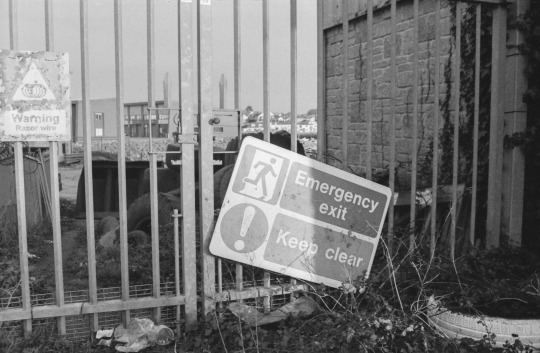

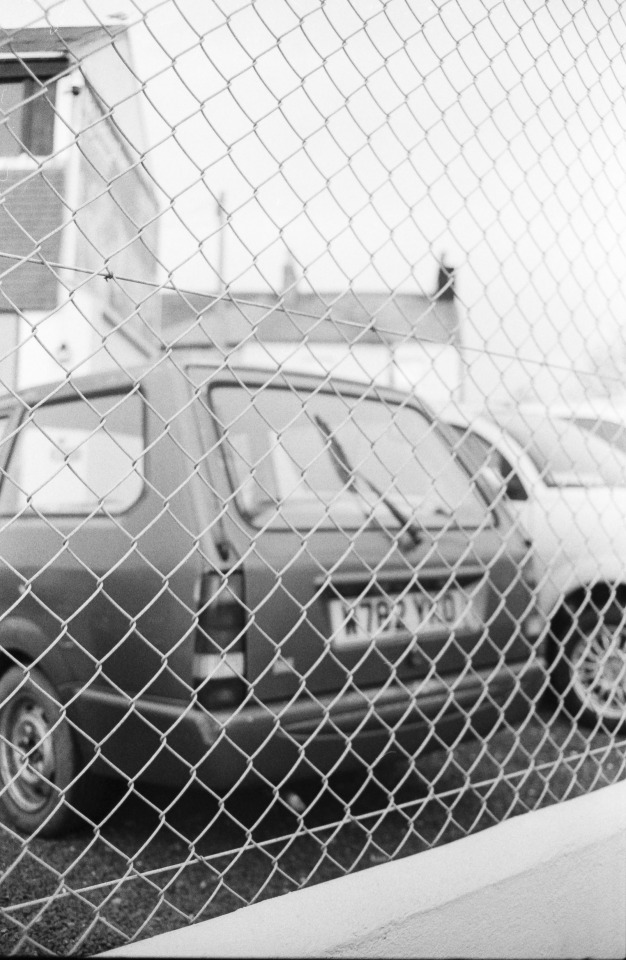

These were taken on a freezing January afternoon, testing a rare model soviet camera. Unknowingly until now, they were a prerequisite to what I intend to do now, which is documenting the non-place with a 35mm camera in B&W. Of course, there is no flash use but there are deviations to my usual style by including closer detailed photographs, rather than the topographical style of urban landscapes. Nothing was intended for this roll of film apart from making sure the Zenit worked OK, but in retrospect it is a way of working which I thoroughly enjoyed. It was at a time when the first leg of Epochal Territories was well underway and it was a departure from the pressure of the main body of work. It seems ridiculous to make this style of work the main area, thus placing that pressure on top of it, but it would also mean I have space to breath with shots per roll (36 instead of 10), and I can be more creative by developing my own B&W film, as I have a stash of slightly expired Ilford films that need using. I also have a large stash of darkroom paper, where I can experiment in the darkroom and create prints for a potential exhibition towards the end of the year. it brings up the point that it is September and I need to start working. The summer is a horrid time for me to work.
Everything is seemingly heading in the right direction. I plan to start shooting within the next couple of weeks once I have time and the seasons shift, with the light becoming easier to use. I shall experiment with flash also, but I am not entirely sold on the idea and sceptical that it will even work. Rest assured, all will be fine and all of the jigsaw pieces will fall into place.
0 notes
Text
All Ur Viral Phenomena R Belong 2 Us - Lecture&Seminar + Set Task
Meme Dolly Parton - ‘ get you a women who can do it all’, photographs for different platforms - loads of people have followed - how one thing starts another - popular culture


This is America - Childish Gambino - actor, rapper, young, black pop stars, poet - made the video of this is America - nothing you don’t see everyday on TV, home truths, reality of America, Black lives in America - harsh reality of violence against race?, stereotypes, riots, gun violence - his culture
A society full of racism and black stereotypes - trousers and dance link back to slavery (Jim Crow - famous portrayal of black people in America) and how black culture came to America and were oppressed - legacy of slavery represented in song and music video
The music video is a viral phenomenon
1 in 9 black men are in prison in America - more of our age group in this room more black people in prison rather than college
Mayflower 2020 - board is white, posh British yet the mayflower played part in killing 95% of the indigenous Americans
Due to the video being a global phenomena it got memed - mixed together two massive things - call me maybe
Developed into photographic memes as well - links to American politics in meme - Bernie vs Donald - progression from calm to violence
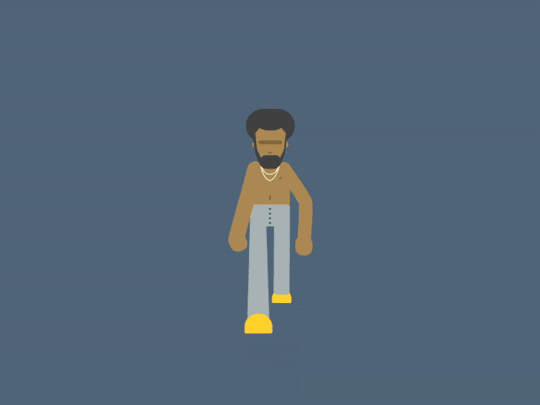
youtube
“Viral phenomena are objects or patterns that are able to replicate themselves or convert other objects into copies of themselves when these objects are exposed to them. They get their name from the way that viruses propagate” - spreads like an illness virus

Meme that describes a meme - explaining their links to culture, etc - read intertextually
Meme culture needs to look back over years of culture to understand
Intertext - every text is talking through something
“The word meme was coined by Richard Dawkins in his 1976 book The Selfish Gene as an attempt to explain the way cultural information spreads; such as beliefs, fashions, stories, and phrases” - the meme about him creating the meme - in his books talks about how we are memes due to over genes copying themselves - how cultural information spreads
“When you plant a fertile meme in my mind you literally parasitize my brain, turning it into a vehicle for the meme’s propagation in just the same way that a virus may parasitize the genetic mechanism of a host cell.” - we decide what a successful meme looks like
A virus population explodes by how many people it touches

Stanley Milgram - Conformity and Independence - if people were looking up in the street passers by looked up too - FOMO - memes are fomo - fear of missing out - we won't help until someone else steps out to help
As humans we follow order to not be the weird link in the group - always trying to survive - are we really individuals? Following the leader within the group - been proven by social experiments in people were people are put in situations and filmed what they would do
youtube
‘That's clickbait’ - part of meme culture - we click on link
Hashtags - ice bucket challenge - raising money for charity

#metoo movement - Tarana Burke launched me too movement - white washed out of the photograph
Tarana Burke: "We owe future generations nothing less than a world free of sexual violence," she says. "I believe we can build that world." - against sexual assault and harassment followed allegations from Harvey Weinstein

Great Thumberg image - cropped black women out of image that went out across the world - press said the image needed to be tightened - black young girls story is just as important but she got cropped out? Due to her race?
Racial violence went up after brexit.

Memes that reference themselves - intertext
Can do anything with a meme - take on mind of their own
‘Meme’ from 1920’s developed into modern day meme - copied and spread of variations of images


‘Lonelygirl15’ - video blog of her on YouTube - her life portrayed through videos was fiction
Donna Haraway: “the cyborg is a matter of fiction and lived experience”
A “fiction and a fact of the most crucial, political kind” - we are now cyborgs- links to use of technology and memes - written about years ago - we are them as we are so connected
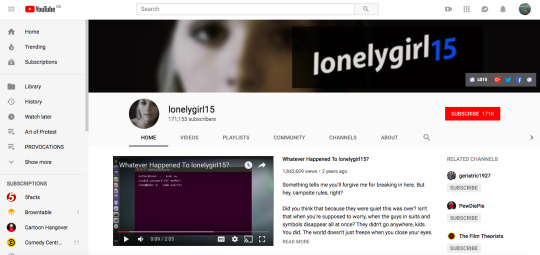
Donald Trump - Memes - reaction - people laughed at something that wasn’t meant to be funny - people of the free world laughed at him - next hour, next day memes of it came out
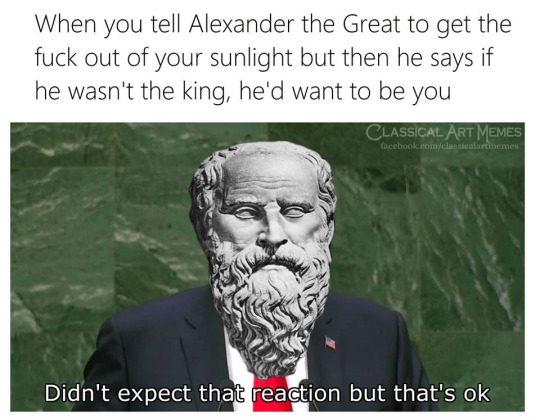
Blue and gold dress - was a marketing ploy
Banksy work shredded after brought fro record money - ‘going, going, gone’ - shredder built into the frame incase it ever sold at auction - sotherbys shocked by stunt
The next morning - different versions of shredded art appeared on Instagram
youtube
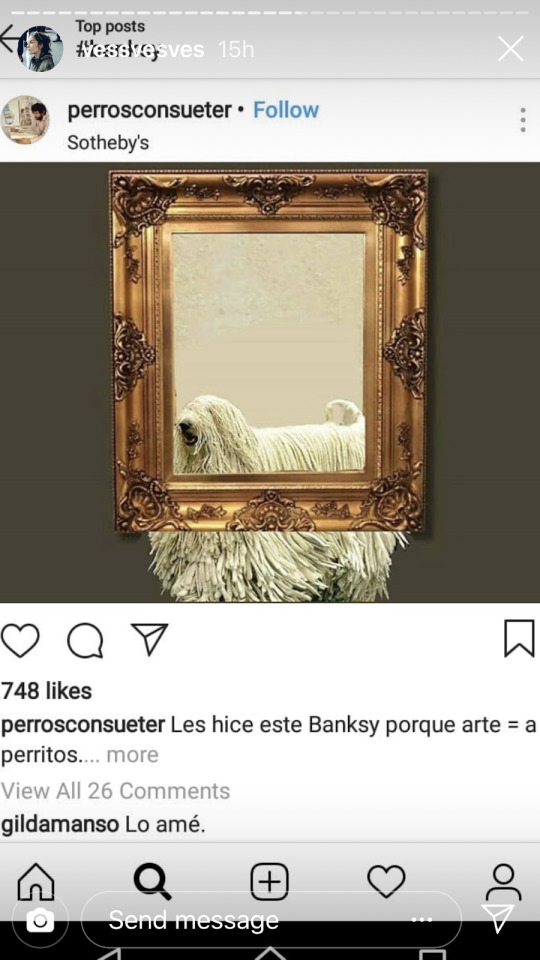

Game of Thrones - very dark - ‘grimdark’ fiction - we live through very dark fiction due to the world happening around us - e.g. The Wicther and The Alienist
Grimdark is being replaced by ‘hope punk’ e.g. star wars
Explore what it means to be good - look for good characters in film and tv


Set Task:
For the set task I decided to explore the role that photographers has in the Me Too Movement.

https://aperture.org/blog/fashion-photography-metoo-era/

https://www.huffingtonpost.co.uk/entry/photography-me-too-women-portraits_n_5acfa0ffe4b077c89ce68b22?ri18n=true&guce_referrer=aHR0cHM6Ly93d3cuZ29vZ2xlLmNvbS8&guce_referrer_sig=AQAAAL8hBrcNJnlzvM2G5iJo89bWhtItoVcfNQkqoYM08qJfDV5TI08ARgriyFvDBtvqbeBjOEfwAaBztNDTaQ6YPMfyRNNNzs1h8Kw6rfO9wgPQFIFIUEYd0kJKA7ihh_f9L_RHULvXPsvWHxAsg9oYHqHcGmd-Ss7tlt9vnpR9iKTb&guccounter=2
Seminar:
Viral phenomena applies to narrative and telling stories
Things go viral for many different reasons
Cultural studies is a way of trying to read how culture works
Books:
The Posthuman: N. Katherine Hayles How we become: virtual bodies in cybernetics, literature, and informatics
The Cyborg: Donna J, Haraway: A Cyborg Manifesto, 1984
How does this theme link back to previous lectures and seminars? It relates to the hauntology lecture with the idea of the end of history, stuck repeating the same things never coming to a conclusion. It also links to nostalgia with the past repeating itself within viral memes. Is creating memes and other viral phenomena a part of our collective utopia?
(Hills and Valleys- direct statement on federal government on women, birth control, family planning, controversial areas - depicts womens hips, vajazzle of government building ) The art of going viral | Niki Johnson - ted talk - gender, power and human rights, being clinically engaged is involved in her everyday life, one piece of work went viral twice - major world event at the same time the art was released, had zero experience with media the first time - way out of comfort zone, art in the media is based on its ability is its public interest, meaning becomes unruly, piece had cultural significance, second cycle was virtual and newspaper
For the seminar task our group choose to focus on the most recent Banksy that has appeared in Bristol and went viral due to his Instagram post.
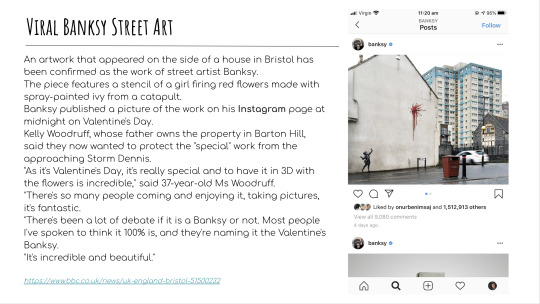

0 notes
Photo

PHOT301 - Mileage May Vary - Research and Influences
Influence is a funny thing. Looking at other’s work has always seemed odd to me as it comes across as you’re ingesting what they create, and then recreating it. To me, it seems somewhat disingenuous to take someone else’s work and make it your own, as it doesn’t seem entirely conducive to create a body of work. Perhaps there’s a disconnect between looking at work, and being influenced by it. Because of this, I don’t tend to look at other photographers work nowadays. The ways that I ingest photographers is usually online, with social media applications - but sometimes I stumble across words of wisdom with passing visiting practitioners such as Nicholas J.R White or Jack Latham. As for social media, its people such as Vlad Tretiak. And past projects such Chris Dorley-Brown’s “Driver’s in the 1980′s”.
How do I get inspired? This, is the million dollar question. Inspiration has been always a stumbling block when it comes to my work: I don’t like looking at other people’s work and taking it and I rarely find work that truly resonates with me. I have always found it easier to shoot more often and see where my eye takes me. One could say that my eye is influenced by what I have ingested, and that could potentially be the case. The other thing that initially inspires me is the contextuality of my practice, which is usually philosophically based with some political undertones. My previous work played a lot on my own experiences living in a modern capitalist society - PHOT201 featured a lot of my own personal feelings on alienation/estrangement, and PHOT102 used my interests of Brutalism. In terms of PHOT301, this is spearheaded by the intrigue of the system that we live in, the 2008 Financial Crisis and the then Labour Government’s 2009 Scrappage Scheme. As well as this, there is the personal appreciation for the everyday vehicle. Mentioned in the post in the first shoot, I talk about how I grew to appreciate the car that the layman use on a day-to-day basis. Cars of a certain age were purged once the Labour Government unveiled the scheme to rid the roads of ageing vehicles, replacing them with newer, safer and more environmentally friendly options.
This scheme was set after the 2008 financial crisis, where banks were allowed to trade through a deregulated system, demanding mortgage schemes which they couldn’t necessarily pay back. This lead to banks like Northern Rock collapsing, which returned to private ownership, but dissolved in 2012. The global financial crisis of 2008 led to a mass recession across the western world, causing the most significant financial crisis since the great depression. In the 2009 budget, the Labour government unveiled the VSS as an incentive for motorists to trade their old car, get a discount, and get a brand new car which offers greater safety, reliability and environmentalism. Governmental information regarding the scheme is easily accessible on the internet, and can be see - https://www.gov.uk/government/uploads/system/uploads/attachment_data/file/357672/bis-foi-2014-20775-scrapped-vehicles-supporting-data.csv/preview .
With this link, one is able to download an Excel file which details all of the vehicles scrapped in 2009. This covers everyday cars of the day like the Rover 214 (of which 2045 were scrapped), as well as odd manufacturers such as Lada’s Riva, where 7 were scrapped. In total, 392227 cars were scrapped in total, according to the spreadsheet in 2009. The document can be seen here - https://drive.google.com/open?id=1azLGX99mmsL79kbA8qnUuV_C8_k3fI--

Meaning, the Government managed to get rid of a number not too far off of half a million undesirable vehicles from the scheme alone. That being said, there are some discrepancies within the document, such as potential duplicates and spelling errors which could hamper the end result.

Thankfully, the ever helpful Government have released a document with the results which states that there is some variability, as the information was collected by the manufactures instead of the Government itself for the VSS (Vehicle Scrappage Scheme). These numbers are fascinating to me - browsing the document also brought up some interesting results. A lot of the manufacturers that are/were stationed in the U.K, such as Ford, Nissan, Peugeot and Vauxhall recorded higher numbers compared to manufacturers such as Mercedes or Volvo for example. This means, there is some potential correlation between vehicle manufacturer location and scrappage numbers, as well as the type of manufacturer that’s marketed. Higher market vehicles, such as Mercedes again saw lower numbers in general, compared to a more consumer based manufacturer such as Toyota. Obviously, this would make sense are Toyota is more of an accessible option compared to Mercedes.
Top 5 Scrapped cars from 2009/2010
Ford Fiesta - 13622
Nissan Micra - 11808
Vauxhall Corsa - 10453
Volkswagen Polo - 8432
Vauxhall Astra - 8066
(info provided with the VSS Spreadsheet linked above)
This is intrinsically fascinating to me, as it puts into perspective the number of vehicles that were rid within the period of the scheme. Despite the high number of scrapped cars, many of these models still roam our streets. There is a great website titled ‘https://www.howmanyleft.co.uk/’, which collates Governmental data on cars that are left on our roads. The website can be used to search models of cars that are still being used today, which details cars that are being used on the road, as well as cars that have been SORN. For example, we saw that 2045 Rover 214s were scrapped in 2009. Today, there are only 155 left on the road, with 189 SORN (not on the road). The graph the website offers shows the rapid decline in 2009, correlating with the VSS. This can also be used to see the gradual decline of the vehicle’s usability, whether that’s due to owners discarding it or replacing it.

This information spearheads the project, mostly in it’s entirety. This projects sets to document what’s left behind from the VSS, as well as the vehicles themselves. Each one is different despite it being made identical in the factory with robots and humans. Each and every car has been used differently by different people, and this shows different ways in which it has been worn and battle torn. These can take the form of scrapes, dents and missing pieces of trim - which can sometimes be enough for one to scrap their car. Despite the scheme being scrapped in itself in 2010, VSSs are still being employed by manufacturers and website on the internet. This means that these cars aren’t all that safe after all. They might have missed the initial barrage of time, and the Government’s scheme, but at any moment they could be still given into the dealership and discarded, being recycled into a fancy washing machine or a bean tin. Manufacturers such as Citroen and Vauxhall still offer such schemes, with money-off incentives on new models, as well as a scheme in London set by Sadiq Khan, with vehicles such as mini vans and mopeds to be scrapped to reduce carbon emissions in London, with an ultra low emission zone in London by October 2021 (TfL, 2019).
There is also a somewhat philosophical aspect to this body of work, also. Hauntology has risen in popularity within the last decade, with Mark Fisher potentially reviving it into the focus of conversation with his easily accessible writing. At first, I found Derrida’s original explanations absolutely horrid to understand. His writing (to me, at least) was often confusing and convoluted. Thankfully, Fisher’s writing in Ghosts of my Life and What is Hauntology offer realistic and easily understandable explanations on what Hauntology really is, and how it’s applicable to our contemporary zeitgeist. It can really be distilled into ‘a time out of joint’ (p.21. Fisher. M. Ghosts of My Life). Hauntology is really the philosophy of the past haunting the present. Derrida links Communism being a spectre on western Capitalism. This, can be applied to almost anything within popular culture, in addition our world now. Fisher also mentions our futures, due to our mixture of past melding with our current times. Things have been increasing harder to see what the future really is, as our times become more anachronistic. This all plays into my work, in terms of subject and what it has been taken on. The cars themselves are inherently anachronistic, as they belong from a different time period. And, the images themselves have been taken on cameras that should, in essence, be extinct - hence digital photography has taken the spotlight in contemporary image making.
Although, film photography certainly is a spectre hanging over digital photographer, and offers up a form of spectral nature of itself. Yet, there is still a place and a market for analogue photography, despite companies either discontinuing their stock or raising prices. The rationale of shooting film is purely a personal choice. It isn’t because I think it’s better than digital, it’s because I enjoy the tactility of the equipment, and the process of scanning in a physical photograph. There are so many more nuances and variables that can’t be corrected once it has been taken, and can only really be corrected once it has been digitised with a scanner. It may even defeat the point when an analogue image is digitised, as the scanner is interpreting the tones and colours of the film with its processing and software - scanning with different scanners can vary everything about the film. I found this out when I bought my own Canoscan 9000F MKii in first year, and there is a massive quality difference between the Canoscan and my favourite scanner: the Epson V850 Pro. This, of course is due to the large price difference and aim towards the demographic. The Canoscan is aimed purely at the enthusiast who needs a scanner, and might potentially need to scan the odd roll of film. The Epson is of course aimed more towards the professional, with the increase in scan quality and scanning options. With this, there are quality differences, with the Epson scanning a lot flatter, with increased dynamic range, compared to the Canoscan’s odd colour cast and contrast increase.
Visual Inspiration
Vlad Tretiak - A Small Town in Siberia II
As mentioned before, I find visual inspiration often hard to come across, with a feeling of nihilism towards looking at photographers of the past. Many copy established photographers which to me, renders the image useless as you’re just recycling someone else’s project or aesthetic. I do feel that it’s good to look at photographers and take notes from what they create, but not totally rip off what they have already done. The biggest inspiration for my work at the moment is a little known photographer based in Russia, called Vlad Tretiak. He is a Russian based photographer and graphic designer. His work centres around parked cars in the dusk hours, with Tretiak often utilising street lights to enhance the aesthetic of the image. The cars he documents aren't brand new offerings from the automotive conglomerates; they're often bruised Ladas and Japanese obscurities, as well as documenting the spaces that these cars occupy.
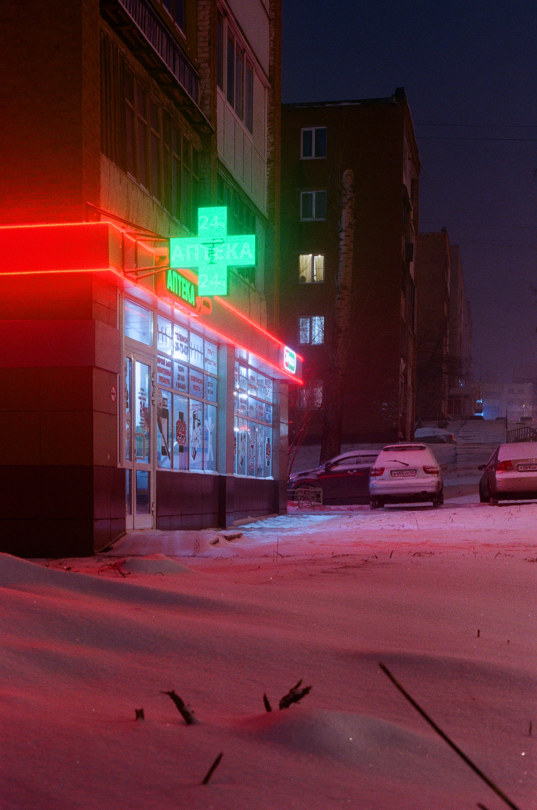
The project doesn't just focus on the cars, but also the small town in Siberia, which is Kemerovo - a town closer to China than Moscow. The landscape is often ridden with Siberian snow and the town's neon lights creates an almost vaporwave feel to his work. They're also incredibly cinematic, with an almost tangible look and feel. Tretiak shoots mainly on a Pentacon Six or a Mamiya C33, often with expired film, such as using Kodak Aerocolour III; which has long since been expired. This gives Tretiak's work a hauntological aspect, as he is shooting scenes with film that shouldn't exist in this time (theoretically). With this, it creates a haunted present, as it's presented on a format that is from another time period - unlike shooting fresh film which has been produced in the contemporary sense, but uses the same formula.
All of these aspects makes Tretiak a key piece of research for Mileage May Vary, as it shares a lot of the same themes and aspects as mine. The biggest thing I can learn from A Small Town in Siberia II, is the use of lighting. My previous analogue night photography attempt was lacklustre purely due to the light, as well as not exposing the film for long enough to get some of the shadow detail. I do plan on shooting on some expired film for my project, and as older film usually needs longer to expose, this will lengthen the night exposures exponentially. Yet, Tretiak manages to keep these images looking crisp, clean and clinical. The images are incredibly sharp and features such a deep tonality. There aren’t many practitioners that when I look upon their work, I think to myself that this is what I want to be striving for. a lot of the time, I blankly gaze at work and nothing works for me, but there is something about how Tretiak manages to capture the scene, isolate the subject and use natural, and artificial light to his advantage. The scenes are also so mundane to the layman, as they are just Ladas being photographed in their natural environment in Russia.
This also has another link to Hauntology, as these cars are haunted by the spectre of Communism itself. They were born from the CCCP, lived through the state and now survive in a Capitalist Russia, and then they are documented on a process which has been superseded by a digital process. They’re scenes haunted by Communism, taken by a haunted process. It makes one think how omnipresent Hauntology really is, and this is the reality that we live in. It also makes me think that I have always had links to the CCCP and Hauntology without me really knowing. I have managed to document Brutalist structures and things of the past, but in the present; but its only now that I am able to see what I have been doing and it’s contexts.
Below, is a number of Tretiak’s images from that project which I really enjoy.

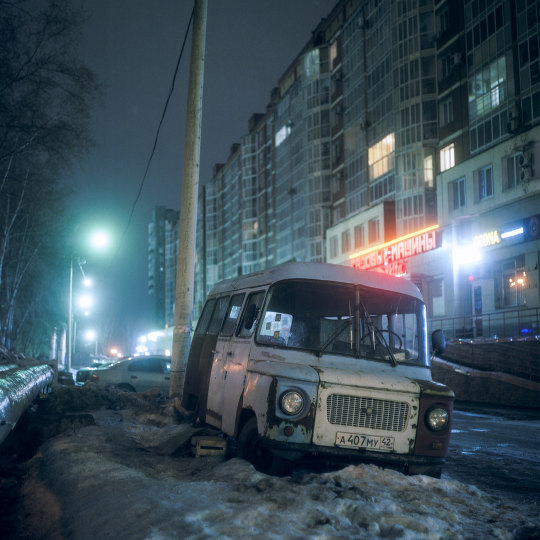


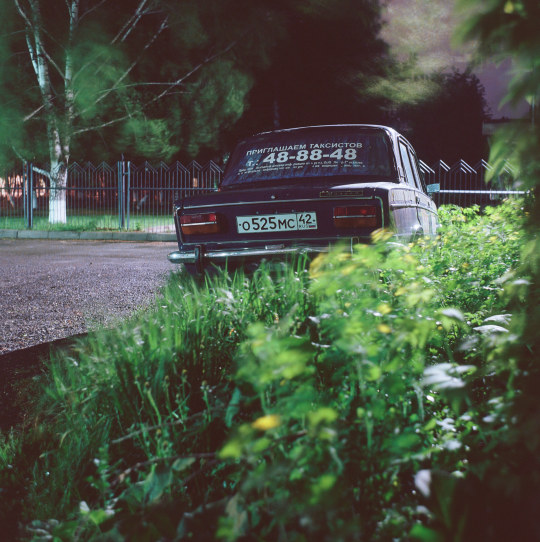
Chris Dorley - Brown - Drivers in the 1980′s
I came across Dorley-Brown’s work due to Jack Latham recommending his project to me to look at for MMV. The project in question is Drivers in the 1980′s; a documentation of drivers stuck in East London traffic jams in the summer months during the 80′s. Dorley-Brown initially wanted to document the privatisation of Rolls Royce, but instead chose to photograph the faces of the traffic jams of Thatcher’s Britain. For me, its a very humanising project to look upon, and feels slightly odd enjoying a body of work which features actual people. I often feel slightly alienated to look at work with people in them, as I don’t really have any or no connection to the subject. Yet, a lot of the images within this project feel very candid and Cartier-Bresson-esque in terms of their decisive moment feel. That being said, some of the subjects have noticed Dorley-Brown and posed for the camera, knowing they will be photographed and changed their pose ala-Barthes.
Speaking of Barthes, Dorley-Brown’s work feature both studium and punctum. The studium is the subject, and something about it that has jumped out to Dorley-Brown, and the punctum is the end result of that studium. And the end result is rather aesthetically pleasing for what is essentially a portrait of the urban environment.



There is an immediate aesthetic to these images that just shout out 1980′s, purely because of the tones and colours. There is something about these aspects of which I enjoy, and I am not entirely sure why that is. Perhaps its linked to nostalgia, as these was only taken 10 years before I was a small child, and I can remember seeing photographs in a similar style to these. Either that, or its the cars included in the photographs, which I used to see when I was younger and feel nostalgic about seeing; or that I have fallen for the Capitalist ploy to sell me nostalgia of the 1980′s despite never actually experiencing it first hand. There must be something with the emulsions used at the times, causing these bold, yet washed out colours. All of these photographs were taken with either a Rolleiflex 3.5 or a Mamiya C33 (as did Tretiak in ASTiSii). In addition, eight rolls of film were shot in a space of six hours, with a total of 162 photographs. Dorley-Brown is noted in saying about shooting the project:
“They are both waist-level finders so that put me at driver level and helped me be a bit more invisible,” he wrote via email. “People are never sure with those viewfinders whether you are looking at them or not so it gives you some space to work without appearing too obtrusive.”
This gives one insight in the creation of the work, and the use of a TLR camera. They are something that I really want to love, but hate using. Looking down at the viewfinder always feels very unnatural to me, and the inverted movements always throw me off. However, this hasn’t stopped me looking at purchasing a Mamiya C33 or equivalent down the line. Perhaps I will learn to love TLRs, just like I learned to love square format images, and seeing as the C33 is 6x6, its another hurdle to overcome.
Franck Bohbot - Parked Cars
Bohbot is a French born photographer and film maker based in New York. His images offer a cinematic and meticulous approach to image making. They also offer a certain atmosphere that juxtaposes the reality of the day to day. I will be focusing on Bohbot’s ‘Parked Cars’ project. I used Bohbot during the Economy Exhibition, as he used a very similar composition style to what I was already doing. I found the typography of his images very Becher-esque and visually intriguing, as its interesting to see a lot of cars presented like this.

Parked car, Parkslope #1 Brooklyn, NY, 2013
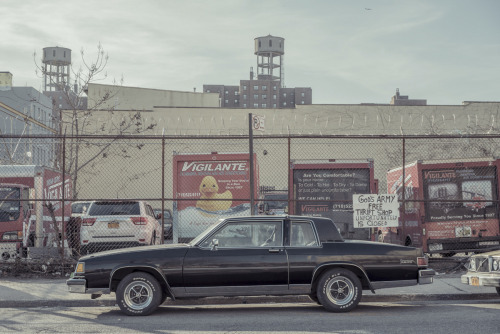
Parked car, Gowanus #5, Brooklyn, NY, 2014

Parked Car, Gowanus #6, Brooklyn

Untitled
Bohbot offers an interesting take on a typographic style of automotive photography. It manages to capture the vehicle, as well as the surrounding space around it. They often tell us things about the area as well, just like the state of the economy and the grade of social status of the occupants. The photographs also tell us what kind of life the vehicles have lead. Just like the Camaro Iroc-Z above, it has discoloured/faded panels. This could mean they have been replaced because its had a collision, or they have just faded over time. Red paint has a habit of doing that as the wavelengths absorb more light compared to other colours, and the UV light degrades the paint faster (oh my previous life as a mechanic and body repairer). This can also be seen on the Caprice Classic at the top, as that has heavily faded and also started to rust around the wheel arches. These elements especially reflect on what I am doing, and focusing on the cars that have aged and seen some years of use. These scrapes and scars can tell a story of what the vehicle has gone through, and shows that its just a mode of transport that someone uses.
Since looking at Bohbot’s work in first year, it has been updated with more detailed and less typographic images. An example is of the Pontiac GTO’s rear lights/badge. Just like my current work, it incorporates a more detailed look at the wear and tear of the vehicle, in addition to using a shallow DOF to isolate the subject.
A Coda
Being inspired and influenced by practitioners is something I find that’s hot anc cold. Quite often, I rarely find photographers that I really get and understand. It seems all too often I blankly stare at ones work and it doesn’t do a thing for me, and I tend to find it easier to just go out and shoot, without any prior research to see where my creative mind is at. Although, I do find that sometimes, one does need to ingest other’s work and get some insight into how they create that work - whether that is due to the camera or film they have used, or the way that they have composed and taken the photograph. Of course, this can be a valuable asset to the photographer to gain insight into how to make a photograph just that little bit better, or something to avoid if they haven’t executed it properly. With Tretiak, Dorley-Brown and Bohbot, they have certainly informed and influenced how I make my work. I enjoy all of their images, and find it fascinating how they actually make their work, as well as the context within them. Yet, these projects seem different, and oh so similar at the same time. Tretiak is documenting the vehicles that lay dormant where he resides, and Dorley-Brown documents similarly dormant cars, but in the hustle and bustle of the nation’s capital. Finally, Bohbot documents the dormant and parked cars in Brooklyn, where the social and economic background is vastly different to the Manhattan setting that most people think of when New York is mentioned. All of these play a key roll in my work, and are useful to further my practice.
I also find its key to have some contextual backing to the work. All the way back in PHOT202, I ditched anything contextual and focused on the aesthetic of the photograph. This wasn’t a great idea, as it totally sabotaged my grades and was harshly scrutinised - deservedly so. Just like a broken record, I repeat to say that I hated PHOT202 and it’s outcome. Now, I am creating work that I am proud to be attributed to and willing to progress with. MMV is a project that feels that it will last me a long time, as previous projects felt as if they died as soon as they were handed in and never felt as personal as they were portrayed to be. But somehow, MMV feels as if I can keep this project going, even past university is over for me. Perhaps this is because its something that I want to be creating, rather than interpreting a brief and making something fit with brute force.
Bibliography
Behance, (2019). A Small Town in Siberia II. Behance. [Online]. Available at https://www.behance.net/gallery/81633539/A-Small-Town-in-Siberia-II. [Accessed on 01/12/2019]
Franck Bohbot’s Portfolio. (2019). Franck Bohbot’s Portfolio - Parked cars | 2013-2015. [online] Available at: http://www.franckbohbot.com/parked-cars [Accessed 1 Dec. 2019].
Franck Bohbot’s Portfolio. (2019). Franck Bohbot’s Portfolio - Parked cars | 2013-2015. [online] Available at: http://www.franckbohbot.com/parked-cars#e-5 [Accessed 1 Dec. 2019].
Franck Bohbot’s Portfolio. (2019). Franck Bohbot’s Portfolio - Parked cars | 2013-2015. [online] Available at: http://www.franckbohbot.com/parked-cars#e-35 [Accessed 1 Dec. 2019].
Franck Bohbot’s Portfolio. (2019). Franck Bohbot’s Portfolio - Parked cars | 2013-2015. [online] Available at: http://www.franckbohbot.com/parked-cars#e-8 [Accessed 1 Dec. 2019].
Franck Bohbot’s Portfolio. (2019). Franck Bohbot’s Portfolio - Parked cars | 2013-2015. [online] Available at: https://www.franckbohbot.com/6914744-parked-cars#e-24 [Accessed 1 Dec. 2019]
Rosenberg, D., (2015). Being Stuck in Traffic Never Looked So Good. Slate. [Online]. Available at https://slate.com/culture/2015/06/chris-dorley-brown-drivers-in-the-1980s-is-a-look-back-at-london-car-culture-photos.html. [Accessed on 14/01/2020]
Fisher, M., (2014). Ghosts of My Life: Writings on Depression, Hauntology and Lost Futures. John Hunt Publishing (p.21.)
Jones, M., (2016). Angry drivers stuck in London traffic during the Eighties. British GQ. [Online]. Available at https://www.gq-magazine.co.uk/article/drivers-1980s-book-london-hoxton-press. [Accessed on 14/01/2020]
Transport for London, and Matters, E. J., (no date). ULEZ Car and motorcycle scrappage scheme. [Online]. Available at https://tfl.gov.uk/modes/driving/ultra-low-emission-zone/car-and-motorcycle-scrappage-scheme. [Accessed on 08/01/2020]
0 notes
Quote
Depression is the most malign spectre that has dogged my life – and I use the term depression to distinguish the dreary solipsism of the condition from the more lyrical (and collective) desolations of haunto-logical melancholia. I started blogging in 2003 whilst still in such a state of depression that I found everyday life scarcely bearable. Some of these writings were part of the working through of the condition, and it’s no accident that my (so far successful) escape from depression coincided with a certain externalisation of negativity: the problem wasn’t (just) me but the culture around me. It’s clear to me that now the period from roughly 2003 to the present will be recognised – not in the far distant future, but very soon – as the worst period for (popular) culture since the 1950s.
Mark Fisher, 'The Slow Cancellation of the Future,' from Ghosts of My Life: Writings on Depression, Hauntology and Lost Futures
#mark fisher#cultural theory#hons#i think this is true of music which seems to have been Fisher's thing#i don't necessarily thing it's true of television; i think television is as interesting + important as it has ever been#but this also might have been written before television got 'good'#ie the golden age which started in the early 2000s
2 notes
·
View notes